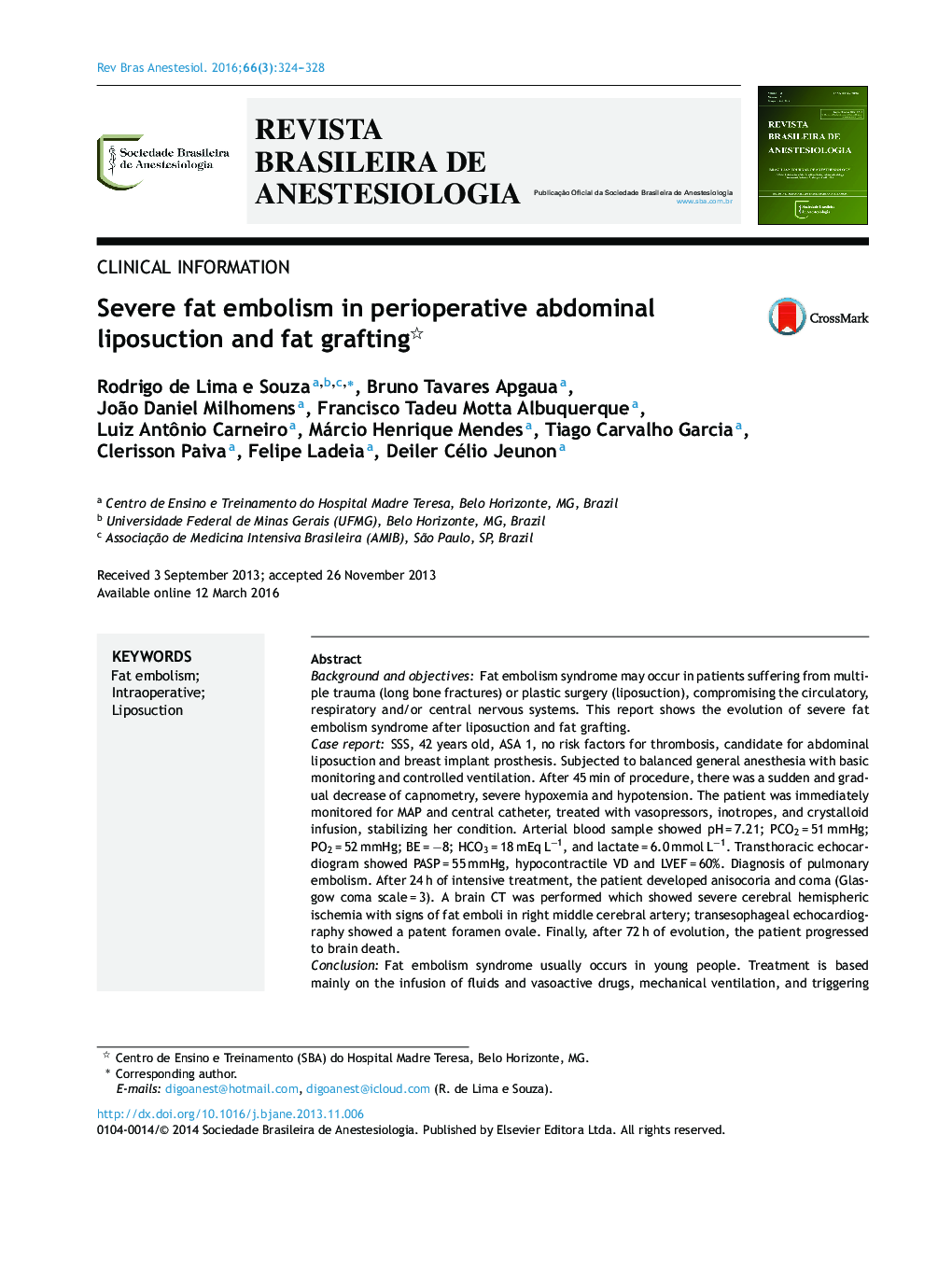| کد مقاله | کد نشریه | سال انتشار | مقاله انگلیسی | نسخه تمام متن |
|---|---|---|---|---|
| 2750179 | 1567298 | 2016 | 5 صفحه PDF | دانلود رایگان |
Background and objectivesFat embolism syndrome may occur in patients suffering from multiple trauma (long bone fractures) or plastic surgery (liposuction), compromising the circulatory, respiratory and/or central nervous systems. This report shows the evolution of severe fat embolism syndrome after liposuction and fat grafting.Case reportSSS, 42 years old, ASA 1, no risk factors for thrombosis, candidate for abdominal liposuction and breast implant prosthesis. Subjected to balanced general anesthesia with basic monitoring and controlled ventilation. After 45 min of procedure, there was a sudden and gradual decrease of capnometry, severe hypoxemia and hypotension. The patient was immediately monitored for MAP and central catheter, treated with vasopressors, inotropes, and crystalloid infusion, stabilizing her condition. Arterial blood sample showed pH = 7.21; PCO2 = 51 mmHg; PO2 = 52 mmHg; BE = −8; HCO3 = 18 mEq L−1, and lactate = 6.0 mmol L−1. Transthoracic echocardiogram showed PASP = 55 mmHg, hypocontractile VD and LVEF = 60%. Diagnosis of pulmonary embolism. After 24 h of intensive treatment, the patient developed anisocoria and coma (Glasgow coma scale = 3). A brain CT was performed which showed severe cerebral hemispheric ischemia with signs of fat emboli in right middle cerebral artery; transesophageal echocardiography showed a patent foramen ovale. Finally, after 72 h of evolution, the patient progressed to brain death.ConclusionFat embolism syndrome usually occurs in young people. Treatment is based mainly on the infusion of fluids and vasoactive drugs, mechanical ventilation, and triggering factor correction (early fixation of fractures or suspension of liposuction). The multiorgânico involvement indicates a worse prognosis.
ResumoJustificativa e objetivosA Síndrome da Embolia Gordurosa (SEG) pode acontecer em pacientes vítimas de politrauma (fratura de ossos longos) ou operações plásticas (lipoaspiração), comprometendo circulação, respiração e/ou sistema nervoso central. O presente relato mostra evolução de SEG grave após lipoaspiração e lipoenxertia.Relato do casoSSS, 42 anos, ASA 1, sem fatores de risco para trombose, candidata a lipoaspiração abdominal e implante de prótese mamária. Submetida à anestesia geral balanceada com monitorização básica e ventilação controlada. Após 45 minutos de procedimento, houve queda súbita e progressiva da capnometria, hipoxemia e hipotensão grave. Imediatamente foi monitorizada com PAM e cateter central, tratada com vasopressores, inotrópicos e infusão de cristaloides, obtendo estabilização do quadro. Amostra sanguínea arterial mostrou pH = 7,21; PCO2 = 51 mmHg; PO2 = 52 mmHg; BE = −8; HCO3 = 18 mEQ/l e lactato = 6,0 mmol/l. Ecocardiograma transtorácico mostrou PSAP = 55 mmHg, VD hipocontrátil e FEVE = 60%. Diagnóstico de embolia pulmonar. Após24 h de tratamento intensivo, a paciente evoluiu com anisocoria e coma com escala de glasgow 3. Realizada TC de encéfalo que evidenciou isquemia cerebral grave, hemisférica, com sinais de êmbolos de gordura em A. cerebral média D; o ecocardiograma transesofágico mostrou forame oval patente. Finalmente, após 72 h de evolução, a paciente evoluiu para morte encefálica.ConclusãoA SEG ocorre geralmente em jovens. O tratamento baseia-se principalmente na infusão de líquidos e drogas vasoativas, ventilação mecânica e correção do fator desencadeante (fixação precoce de fraturas ou suspensão da lipoaspiração). O comprometimento multiorgânico indica pior prognóstico.
Journal: Brazilian Journal of Anesthesiology (English Edition) - Volume 66, Issue 3, May–June 2016, Pages 324–328
